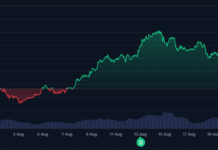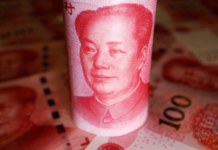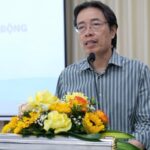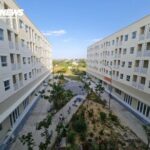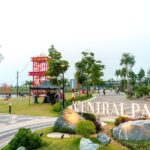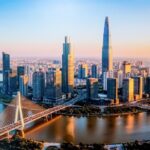At the annual regional conference program “UOB Gateway to ASEAN” in 2024 with the theme “ASEAN – The Intersection of Global Economic Integration,” Mr. Phan Van Mai – Member of the Central Executive Committee, Vice Secretary of the City Party Committee, and Chairman of HCMC People’s Committee shared many potentials in Ho Chi Minh City and the Southeast region to attract investors.
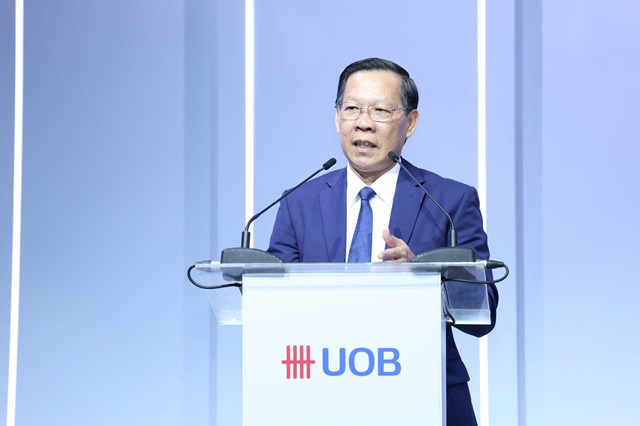
Mr. Phan Van Mai – Member of the Central Executive Committee, Vice Secretary of the City Party Committee, and Chairman of HCMC People’s Committee shared at the event on the morning of September 6, 2024.
|
The Chairman of the City People’s Committee shared at the workshop that the Southeast Asian region, including Vietnam, is affirmed as the fastest-growing region in the global economy today and continues to be the driving force of the world economy. And according to forecasts by organizations such as WB, IMF, the growth of Southeast Asia and Vietnam will continue to be high in 2024 and the following years. With the geopolitical developments, trade competition, the world picture has many points of special interest.
However, the restructuring of the supply chain over time has been shifting from China to India and Southeast Asian countries.
The change in consumer behaviors and habits through e-commerce, green tourism associated with safe and friendly destinations, and associated healthcare services are forming and developing. Sustainable development has become a pervasive trend in the world. Circular economy, green economy, and digital economy are the development models of many countries. This is both an opportunity and a challenge for developing economies. In addition, the pace of urbanization and the development of smart cities is increasing. The formation of financial centers and innovation hubs among major cities is growing at a very high rate. It can be said that science, technology, and innovation have profoundly impacted countries, including Vietnam and Ho Chi Minh City, presenting both opportunities and challenges.
Ho Chi Minh City is ready to attract investors
Facing the current trend, Ho Chi Minh City always strives to keep up with the world and regional trends and confidently continues to affirm its position as a major center for economics, culture, society, education, and science and technology and will continue to be the economic leader and growth pole of the Southern region.
With determination and affirmation, Ho Chi Minh City will be a major center of economics and finance, always ready to cooperate and create favorable conditions for partners to deploy successful business in Ho Chi Minh City.
Investors will be interested in market potential, investment environment, the degree of integration of Ho Chi Minh City and the Southeast region into logistics supply chains, and interested in human resources and the ability to adapt to market requirements.
Ho Chi Minh City contributed 16% of the country’s GDP and 26% of the state budget. This is a significant contribution and must come from the city’s economic internal resources. And more broadly, the Southeast region has made significant contributions to GDP and the state budget.
Ho Chi Minh City inherits a specific mechanism and policy that are superior to the country’s institutional level. This is also a favorable condition to be able to attract strategic investors in priority sectors such as building innovation centers, research and development centers, international financial centers, and investing in technology transfer research in fields such as information technology, biotechnology, automation technology, new materials technology, clean energy, integrated circuit design technology, technology design, manufacturing components, microcircuits, electronics, flexible electronics, chips, and new battery technology… These are the fields in which Ho Chi Minh City has superior mechanisms and policies compared to the common ground of the country for strategic investors.
In addition, Ho Chi Minh City has a specific mechanism in constructing a belt road, synchronous expressways, and traffic infrastructure connecting the Southeast region and the Mekong Delta to expand economic space and create a geographical advantage, a strategic advantage in economic infrastructure and logistics. Ho Chi Minh City has a diverse transportation infrastructure system, including road, air, rail, and waterway transport. In terms of logistics, Vietnam, in general, and Ho Chi Minh City, in particular, have improved infrastructure and cargo handling capacity. Logistics has made an important contribution to making Vietnam one of the 20 largest countries in international trade. Ho Chi Minh City is urgently completing the logistics traffic infrastructure system within Ho Chi Minh City and connecting with the Southeast region and the Mekong Delta, which will be basically completed before 2030.
In terms of industrial infrastructure, Ho Chi Minh City has 17 export processing zones and industrial parks in operation. Currently, the city has a project to transform these industrial parks toward high technology and integrate industry and services to form innovation centers, research and development centers. At the same time, Ho Chi Minh City also plans to build new industrial parks to serve investors.
In terms of human resources, it can be said that Ho Chi Minh City and the Southeast region have abundant and relatively high-quality human resources, meeting the requirements of investors. Currently, more than 50% of Vietnam’s population is of working age. It is forecasted that by 2030, Vietnam’s population will reach about 105 million people, including 58 million laborers. Ho Chi Minh City is a place that gathers high-quality professional labor resources with nearly 5 million workers, and the surrounding areas such as the Southeast region and part of the Mekong Delta have abundant human resources in terms of quantity and quality compared to other regions.
Regarding the readiness of the supply chain, the city has nearly 400,000 businesses, accounting for about 32% of the number of enterprises in the country, operating in all fields and industries, closely linked with enterprises in all localities and having international relations with associations and participating in ASEAN supply chains.
Regarding the critical factor of the market, Ho Chi Minh City has a population of over 10 million, with relatively high income and good spending habits. Still, Ho Chi Minh City is located in the Southeast region and closely linked to the Mekong Delta, with a population of nearly 40 million. This is a significant and very potential market.
Currently, Vietnam has participated in 19 bilateral and multilateral FTAs with almost all economies globally, 16 of which have taken effect, with more than 60 partners spanning continents, with a total GDP of nearly 90% of the global GDP and a population of over 4.8 billion people. “This is a vast market for us to strategize our business, with Vietnam – the gateway to ASEAN – as the focal market, the first stop. However, we are confident that we can expand our market through market linkage mechanisms such as FTAs.”
Currently, 125 countries and territories are investing in Ho Chi Minh City with more than 13,000 projects and a total investment capital of nearly US$90 billion. Singapore is the largest investor with nearly 2,000 projects. Hopefully, Ho Chi Minh City, in particular, and the Southeast region will welcome more investors.
“Ho Chi Minh City is a place where the essence of many different cultures converges, a city of multiple religions, languages, and cuisines, a city that is open-minded, hospitable, livable, where investors can exchange trust, invest, and succeed. Ho Chi Minh City is ready to welcome, accompany, and cooperate with investors to create value and harmonize interests. Your success is the success of the city government and the people”, shared Mr. Phan Van Mai.























